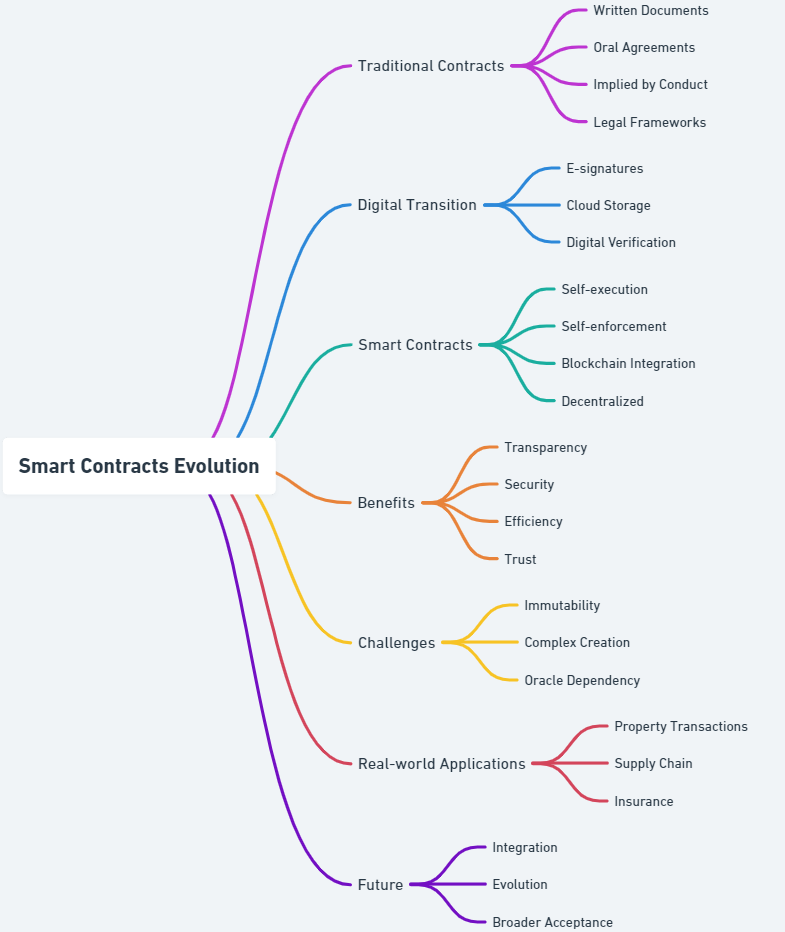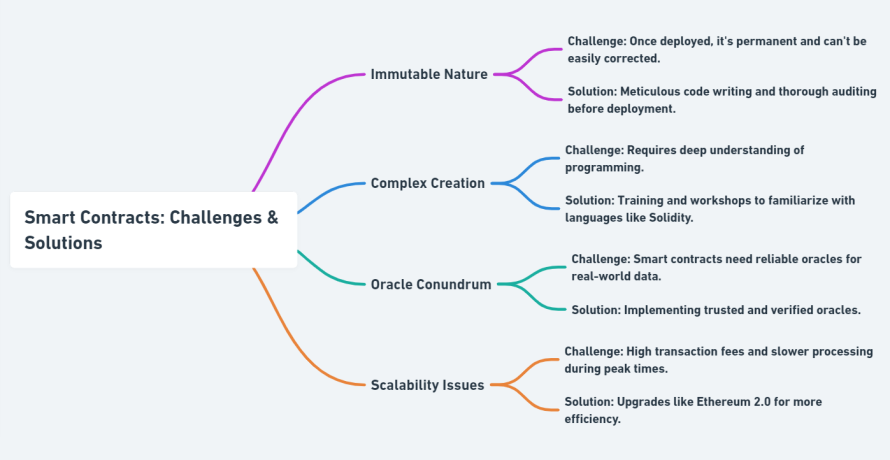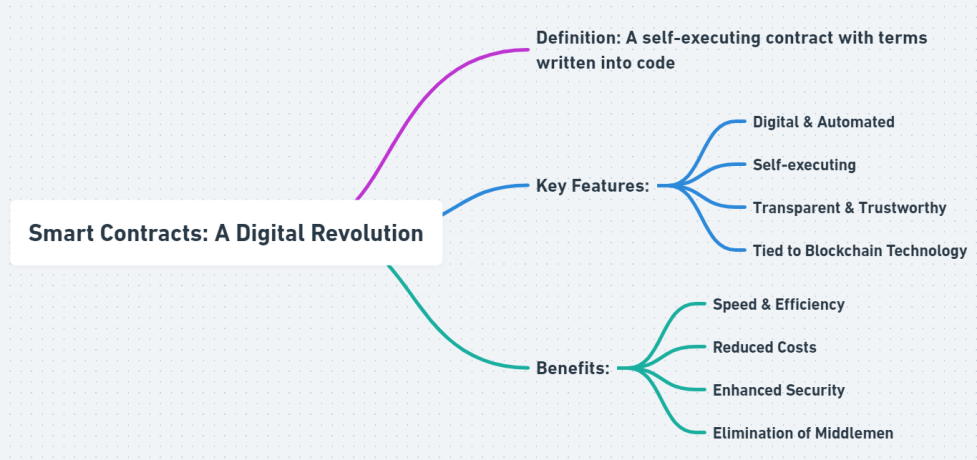
In the digital age, "Smart Contracts" have emerged as a transformative concept that merges traditional contract principles with advanced technology. These contracts, unlike conventional paper agreements, are digital and have the unique capability of self-execution and self-enforcement. They operate autonomously, executing actions when predefined conditions are met, providing a level of efficiency and transparency unparalleled by traditional methods. Their operation is deeply intertwined with blockchain technology, combining the trust inherent in contracts with blockchain's innovative capabilities. While they offer immense benefits, such as transparency, security, and efficiency, smart contracts also pose challenges, including their immutable nature and the complexities of their creation.
by Zach Javdan
September 22, 2023
In the midst of our digital era, where innovations and breakthroughs seem a daily occurrence, a singular concept emerges with profound implications: the “Smart Contract.” This isn’t merely a juxtaposition of tech jargon; it represents the confluence of timeless principles of agreement with the ceaseless march of technology.
The term “contract” undoubtedly conjures images of lengthy documents, signatures at the bottom, and perhaps a sense of formality. For centuries, contracts have underpinned our societal transactions — from the sale of land and property to employment agreements. These paper-bound promises, enshrined by legal frameworks, have ensured that individuals and entities can trust one another in their mutual exchanges.
Now, take this foundational concept and imagine injecting it with the power of digital automation, mathematical verification, and decentralization. Enter the world of smart contracts. These are not just digital versions of their paper ancestors; they’re contracts evolved, capable of self-execution and self-enforcement. In essence, they’re programmed to perform actions when certain conditions are met, doing so with an efficiency and transparency traditional methods could only dream of.
But why the term “smart”? It’s not just a marketing buzzword. It’s descriptive of the contract’s ability to act on its own accord, without human intervention, ensuring the terms are met with precision and punctuality. This transformative technology doesn’t merely digitize the old; it reimagines the very framework of agreement for a connected, digital age.
The genesis of smart contracts, though rooted in the age-old principle of agreement, is intertwined with the evolution of blockchain technology. It’s a marriage of trust (from contracts) and innovation (from blockchain) that promises to redefine many sectors, from finance and real estate to healthcare and entertainment.
To truly grasp the potential and nuances of smart contracts, one must first delve into their foundational bedrock, understanding not only their digital mechanics but also their philosophical alignment with the millennia-old concept of trust and agreement. Only then can we appreciate their transformative potential and the broader tapestry of the digital revolution they’re helping to weave.
Traditional Contracts: Beyond the Basics
At its core, a contract represents a mutual understanding between two or more parties. This understanding stipulates certain obligations and responsibilities that each party agrees to fulfill. While many believe a contract must be a written document, in reality, contracts can be oral, written, or even implied by conduct.
Imagine a carefully balanced seesaw in a playground. On one end, you have rights, and on the other, obligations. When two children — representing two parties in a contract — decide to use the seesaw, they come to an informal ‘agreement’ on how to balance their weights. This mutual adjustment and understanding, where one child’s action (or inaction) can affect the other’s experience, encapsulates the essence of a contract. Each party has something they must do (or not do) to maintain the balance.
Contracts aren’t a new phenomenon. They have roots in ancient civilizations. The Romans, for example, had a sophisticated contractual system. They recognized different types of contracts, from simple verbal agreements to more formal, sealed documents. Scrolls, clay tablets, and other ancient artifacts bear testament to humankind’s long-standing need to formalize agreements and understandings.
The strength of a contract doesn’t just lie in the ink on the paper or the words spoken aloud; it’s reinforced by the system backing it. This is where the law steps in. If one party fails to uphold their end of the deal, the aggrieved party can approach the judicial system for redress. Courts interpret the terms of the contract and ensure that fairness prevails. Over the centuries, numerous legal precedents have been set, refining the interpretation and enforcement of contractual agreements.
While the foundational principles of contracts have remained relatively stable, the methods of drafting, signing, and storing them have evolved. From quills and parchments to digital e-signatures and cloud storage, the tools have transformed, but the intent — to capture and honor mutual understandings — remains unchanged.
Taking a holistic view of traditional contracts reveals their intrinsic value in fostering trust, promoting trade, and enabling complex societal and business interactions. As we transition into the digital age, understanding this foundation becomes essential when exploring the exciting realm of smart contracts.
Smart Contracts: Bridging the Physical and Digital Worlds
A smart contract transcends the traditional boundaries of paper and ink. Instead of being limited by physical constraints, it’s a dynamic piece of code existing in the digital realm. This code isn’t just a representation of an agreement—it actively enforces and executes the terms of the contract automatically and without the need for human intervention.
Consider a digital locker that operates using a complex system of gears and levers. You and another person want to make an exchange—you provide a digital key, they provide a digital item. You both agree that upon receipt of the key, the locker will release the item. You place your assets in the locker, and it stands as an unbiased intermediary. The moment the key is provided, the gears turn, the levers move, and the exchange is made instantly, ensuring both parties uphold their end of the bargain.
The concept of smart contracts isn’t entirely new. Computer scientist Nick Szabo introduced the term in the 1990s, well before the advent of popular blockchain platforms. However, the realization of his vision became feasible with the advent of blockchain technology. Ethereum, for instance, expanded the horizons of what smart contracts could achieve, providing a platform where these self-executing agreements could operate in a secure, transparent, and decentralized manner.
The beauty of smart contracts lies in their simplicity of execution. They’re designed to perform specific tasks when triggered by predetermined conditions. This automation minimizes human error and bias. Moreover, since they’re stored on a decentralized blockchain, they’re transparent and tamper-proof, significantly enhancing the trust factor. Every party involved can verify the contract’s terms and watch it execute in real-time, making the process open and reliable.
While smart contracts offer numerous benefits, they’re not without challenges. The immutable nature of blockchains means that once a smart contract is deployed, it can’t be easily modified—even if errors are found. This underscores the importance of meticulous code writing and thorough auditing. Additionally, while they eliminate many intermediaries, understanding and deploying them requires a unique skill set, currently limited to those familiar with blockchain programming.
As the lines between the physical and digital worlds continue to blur, smart contracts stand at the forefront of this convergence. They’re not merely digital versions of traditional contracts; they’re a paradigm shift, reimagining how trust and agreements can be established in a connected, digital world.

An overview of the evolution of Smart Contracts.
Ethereum: Pioneering the Smart Contract Revolution
Ethereum is more than just a cryptocurrency; it’s a pioneering platform that brought the concept of smart contracts to the forefront of technological innovation. While Bitcoin introduced decentralized finance and peer-to-peer transactions without the need for traditional intermediaries, Ethereum took it a step further. It gave developers the tools to craft decentralized applications (DApps) and smart contracts on a global, open-source platform.
Imagine a bustling metropolis. Bitcoin might be likened to a fundamental infrastructure like a railway system—a foundational and transformative innovation. Ethereum, on the other hand, is akin to the entire city’s blueprint, complete with roads, buildings, parks, utilities, and more. Within this sprawling digital city, smart contracts are individual services or establishments—everything from automated car rentals to digital art auctions. Each one operates seamlessly and autonomously, driven by the underlying rules encoded within them.
What makes Ethereum distinct is its built-in programming language, Solidity. This allows developers to write bespoke smart contracts and deploy them on the Ethereum blockchain. These contracts can hold and manage assets, make decisions, interact with other contracts, and even generate new tokens.
While Ethereum is the platform, “Ether” (ETH) is its native cryptocurrency. It serves two primary purposes. First, it acts as a form of value, much like Bitcoin or any other cryptocurrency. Second, and crucially, it’s used to compensate participants who perform computations and validate transactions, often referred to as “gas fees.” This incentivizes users to maintain the network’s integrity and security.
Beyond smart contracts, Ethereum’s platform enables the development of DApps. These are applications that run on a peer-to-peer network, rather than centralized servers. From decentralized finance (DeFi) platforms to digital marketplaces, the ecosystem of DApps is vast and growing. Each DApp can utilize smart contracts to automate specific functionalities and ensure adherence to pre-set rules.
Ethereum, despite its groundbreaking potential, faces challenges. Scalability, high transaction fees during peak periods, and the environmental concerns associated with proof-of-work mining are some notable issues. However, with upgrades like Ethereum 2.0, which aims to transition to a more energy-efficient proof-of-stake mechanism, the platform is continually evolving, seeking to address these concerns and refine its offerings.
Unveiling the Power of Smart Contracts: The Core Benefits
Transparency: Trust Through Visibility
One of the primary tenets of blockchain technology is transparency, and this extends seamlessly to smart contracts. Every term, condition, and execution of a smart contract is visible and verifiable on the blockchain by all parties involved.
Imagine a glass-walled bank where every transaction, every process, and every decision is visible to everyone, both inside and out. That’s the level of transparency smart contracts bring to digital agreements. When a transaction or agreement is executed, it’s as if it unfolds center-stage under a spotlight, with an audience ensuring everything goes as planned.
Such transparency fosters trust among parties. When everyone can see and validate the contract’s terms and its subsequent execution, there’s little room for disputes or misunderstandings. This open visibility ensures that all parties remain accountable to the agreed-upon terms.
Security: Fortresses of the Digital Realm
Blockchain, the underlying platform for smart contracts, is inherently designed for security. By distributing data across multiple nodes (computers) worldwide, blockchains make unauthorized alterations nearly impossible.
Picture a diary that, instead of being hidden under a bed, exists in a thousand copies spread across a city. If someone were to change a line in one diary, the other 999 would highlight the discrepancy, rendering the change moot. In essence, that’s how blockchain and, by extension, smart contracts ensure security.
This decentralized and cryptographic nature of blockchains ensures that smart contracts are safe from tampering, hacking, and unauthorized alterations. It provides a peace of mind that traditional digital contracts, stored in centralized servers, might not offer.
Efficiency: The Fast-Track to Execution
Smart contracts remove the need for intermediaries, paperwork, and manual verification. By automating processes and triggering actions based on pre-set conditions, these contracts ensure swift and smooth transactions.
Think of a train that doesn’t need to stop at intermediate stations before reaching its destination. Without the usual stops (middlemen, paperwork, etc.), the journey (transaction or agreement) is not only faster but also more streamlined.
The efficiency of smart contracts translates to real-world benefits like reduced costs, quicker deal closures, and the elimination of delays due to human errors or bureaucratic processes. Whether it’s instantaneous payments upon the fulfillment of a service or the automated transfer of assets based on specific triggers, smart contracts pave the way for a new age of business efficiency.
In the rapidly evolving digital age, smart contracts emerge as a beacon of hope, promising transparency, security, and efficiency. They are more than just digital agreements; they are a testament to the profound impact of integrating technology and trust in reshaping the future of transactions and collaborations.
Navigating the Complexities: Challenges with Smart Contracts
Immutable Nature: Permanence with a Double-Edge
Once a smart contract is deployed on a blockchain, it’s there permanently. This immutability ensures trust and security, but it also means that any mistakes or unforeseen issues in the contract can’t be easily corrected.
Think of carving an agreement into stone. Once it’s chiseled, it’s permanent. You can’t erase a line or word without it being obvious. That’s how smart contracts are when deployed—they become an unchangeable part of the blockchain.
This means that if there’s an error or loophole in the contract, it might be exploited, or the contract may not function as intended. Developers must be extremely cautious and thorough during the creation phase, often requiring multiple audits and checks before deploying.

A visual breakdown of the primary challenges faced by smart contracts and their potential solutions.
Complex Creation: Crafting with Precision
Drafting and deploying a smart contract requires a deep understanding of programming, specifically in languages like Solidity (for Ethereum). This complexity ensures precision but can also be a barrier.
Think of it as crafting a Swiss watch. Each component, no matter how tiny, plays a crucial role. If a single piece is misplaced or flawed, the entire watch may malfunction. Similarly, every line of code in a smart contract must be accurate and secure.
There’s a steep learning curve for those wanting to dive into smart contract creation. Moreover, the high demand for this expertise means there’s a shortage of skilled developers in the market, which can lead to inflated costs and longer development times.
Interfacing with the Real World: The Oracle Conundrum
While smart contracts excel in the digital domain, they don’t inherently understand or fetch real-world data. They need intermediaries, called “oracles“, to provide external data for triggering specific contract actions.
Imagine a sealed, windowless room (the smart contract) where someone inside needs to know the weather outside. They can’t see or feel it themselves, so they rely on a person (the oracle) to come in and tell them. But what if that person is mistaken, dishonest, or doesn’t show up?
Introducing oracles means introducing potential vulnerabilities. If the oracle provides inaccurate data, the smart contract might execute undesired actions. Ensuring the trustworthiness and reliability of oracles becomes a focal point in integrating real-world data with smart contracts.
Smart contracts undeniably herald a new era in the digital realm, but it’s crucial to be aware of their limitations. By understanding and addressing these challenges, developers and users alike can harness their potential while mitigating risks.

An overview of how Smart Contracts are revolutionizing the digital and traditional contract landscape.
Bringing the Digital to Life: Real-world Applications of Smart Contracts
Property Transactions: A New Era in Real Estate
Property transactions involve transferring ownership titles from the seller to the buyer, traditionally requiring intermediaries like notaries or banks. With smart contracts, these transfers can be automated and made more secure.
Imagine Katharine wants to sell her house to Ezra. Instead of going through weeks of paperwork, they agree to use a smart contract. The contract is programmed such that once Katharine transfers the agreed-upon amount of cryptocurrency to a specific address, the digital title of the house immediately transfers to him. Both parties save time, reduce paperwork, and eliminate the need for intermediaries.
Platforms like Propy aim to facilitate property transactions using blockchain and smart contracts. Users can list properties, negotiate prices, and finalize sales, all in a secure digital environment.
Supply Chain: From Production to Consumer, Transparently
Supply chains involve multiple steps, from raw materials to the finished product. Each stage often has various players. Smart contracts can be used to track products transparently through each phase.
Let’s consider a coffee supply chain. When a farmer in Colombia harvests coffee beans, they can register this event on a smart contract. As the beans are processed, shipped, roasted, and finally sold in a cafe in New York, each step is recorded in the contract. As a consumer, you can scan a QR code on your coffee package and trace its entire journey, ensuring it’s genuinely organic or fair trade.
Companies like IBM’s Food Trust provide blockchain-based solutions for supply chains, enabling businesses to have transparency and traceability in their products.
Insurance: Revolutionizing Claims and Payouts
Insurance policies can be complex, with claims and payouts dependent on specific events occurring. Smart contracts can automate this, ensuring instant payouts based on verifiable triggers.
Tom has a flight insurance policy through a smart contract. Instead of Tom filing a claim if his flight is delayed, the smart contract is connected to flight databases via an oracle. If Tom’s flight is delayed beyond a certain threshold, the smart contract instantly triggers a payout to his account, without him having to do anything.
Startups like Etherisc are developing decentralized insurance platforms where users can purchase policies and receive automated payouts via smart contracts, reducing bureaucracy and wait times.
The Future
Smart contracts aren’t just theoretical constructs; they’re actively reshaping industries. From buying houses to sipping ethically sourced coffee to hassle-free insurance claims, this technology is making waves in the real world. As they become more integrated into our everyday lives, it’s essential to understand their potential and their challenges. With the growing ecosystem of platforms and businesses incorporating them, the future seems poised for a more transparent, efficient, and secure digital age.










